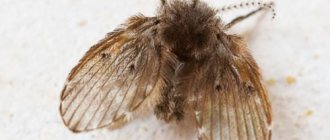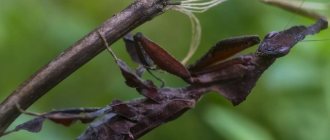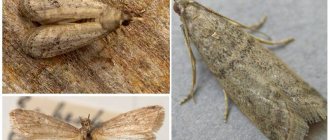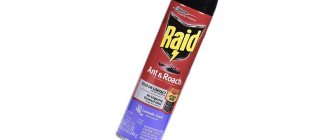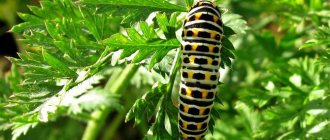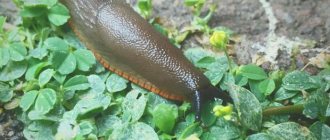What are earth fleas?
This type of flea got its name because of its habitat, but in appearance they are similar to their relatives that live on rats, dogs, cats and other animals.
What they look like
The body length of an adult flea reaches 2-3 mm. Males are smaller than females. The parasite is covered with a durable chitinous carapace of dark brown color. Its body is flattened laterally, which provides good streamlining when jumping.
The body of an insect, consisting of 3 sections, incl. head, chest and abdomen, characterized by an ovoid shape. The abdomen has the largest volume, because it fills with blood as the parasite feeds. The earth flea has 3 pairs of legs. They have serrations that help them cling to the fur and skin of the victim.
Only the hind legs - the longest ones - are used in jumping. The parasite covers a distance of 25-30 cm in one movement. It is believed that it is capable of jumping 75-100 cm in height. The flea, using its hind legs, shoots itself, so its jumps are chaotic.
Parasites have poor vision, but the sensory apparatus present on the back of the abdomen helps to detect even minor vibrations.
In addition, fleas are able to smell the blood and sweat of a victim at a distance of 2-3 m.
Adults have a piercing-sucking apparatus. When attacked, the parasite first pierces the skin and injects a special enzyme that prevents blood clotting and causes severe pain. After this, the flea expands the wound with blades and begins to feed, pumping blood into the expanding abdomen.
What do they eat?
Adults feed only on the tissue of warm-blooded animals. A flea can consume up to 1 ml of blood in one bite. For normal life, the parasite needs to feed at least once every 2-3 days. He makes many punctures on the skin of the legs until he finds a place where the vessels are located close to the surface.
How do they reproduce?
The breeding season for parasites lasts from mid-April to the end of September. During her life, a female can produce up to 500 eggs. Although adults are ready to mate immediately after emerging from the cocoon, the female must first find a warm-blooded animal and bite it. If the act of feeding has taken place, after about 48 hours the flea finds a secluded, cool place with a sufficient level of humidity and begins laying.
It can contain up to 40-50 eggs, covered with a special protective white shell. The eggs of parasites are oval in shape and their size does not exceed 0.1 mm. Under favorable conditions, larvae quickly emerge from them. In most cases it takes no more than 2-10 days.
Flea larvae resemble small worms covered with sparse hairs. They feed on decaying organic matter. After 7-21 days the larva pupates. A flea can spend from 7 to 200 days in the form of a pupa. If conditions are favorable, the insect quickly emerges from the cocoon, becoming an adult.
How long do they live?
Life cycle of a flea.
The lifespan of a flea depends on external conditions. Individuals overwintering in deep layers of soil often die during frosty and snowless winters. Under favorable conditions, they can live 1.5-2 years.
The use of folk remedies in the fight
The insect spreads quickly indoors. Each adult is capable of laying approximately 500 eggs in its entire life. The fight against fleas should begin at the first sign of their appearance in the house.
The most developed sense of the grass flea is smell. It is on this principle that almost all folk methods of dealing with an unwanted neighbor are based.
Traditional methods of combating grass fleas
The most effective ways to get rid of grass fleas in the house:
- Sagebrush. The strong specific odor is extremely difficult for this type of parasite to tolerate. It is necessary to place branches of freshly picked plants around the perimeter of the room. After drying, they need to be replaced with fresh ones. In the same way you can use tansy, pine needles and wild rosemary.
- Table salt. This simple element is found in every home. With prolonged contact with an insect, salt can destroy its shell, thereby leading to death. It is necessary to sprinkle salt on the floor, baseboard, and other surfaces in the house at a height of up to 1 m.
- Vinegar. Soak a small piece of cloth in 9-5% vinegar and treat all surfaces in the house.
- Flea traps can reduce the number of parasites.
Habitats
Ground fleas live in the soil . In winter, they bury themselves 15-20 cm into the ground and pupate. With the onset of warmth, they leave their cocoons and move to the upper layers of the soil. An increase in their numbers is observed when it rained for some time, and then the heat came. High air temperatures and high humidity are the most suitable conditions for these insects. Adult parasites begin to search for a victim.
Fleas don't only live in the ground. They can be found and reproduce in human homes. They live in rooms with high humidity. They attack apartments on the first floors. They are especially common in homes where people neglect sanitary standards.
Good hiding places for them:
- a pile of clothes;
- cracks in the floor;
- folds of upholstered furniture;
- long carpet pile, etc.
In addition, fleas choose outbuildings. They live in animal bedding and places where old things are stored.
The danger of insect bites for humans
Biting insects such as fleas are extremely dangerous because... are carriers of many infectious diseases that require long-term treatment.
Among them:
- plague;
- encephalitis;
- listeriosis;
- anthrax;
- typhus;
- tuberculosis;
- hepatitis;
- tularemia.
Flea bites.
Flea bites are a source of helminthic and fungal infestation. The parasite injects its saliva during feeding. The bite site is very itchy and may become red. People who are sensitive to the enzymes present in the saliva of these fleas may experience allergic reactions.
First aid
The feet, ankles and ankles are the most common sites where the legs are affected. Areas of insect attack may be invisible, but damage to the skin is indicated by itching. If there are no severe allergic reactions, bites can be treated at home.
The affected area must be treated with a disinfectant. A cold compress helps relieve itching. In addition, it is recommended to use an ointment that includes antihistamines. If signs of allergy or intoxication of the body appear, you cannot carry out treatment on your own; you should seek medical help.
If fleas have bitten a child
Focal redness appears on children's skin at the sites of bites. The child experiences severe discomfort due to itching. Bite areas must be treated with a disinfectant and a cold compress applied. If there are many areas of damage, you should consult a doctor, because... Antihistamines may be required to relieve symptoms.
How to recognize flea beetles
First of all, it’s worth finding out what a ground flea is. This name brings together a pair of completely different species.
- Directly fleas, which are also called human fleas. They live in the basement, parasitize, consuming the blood of pets and people.
- Coleoptera fellow Colorado. It is a pest of agricultural land, as it eats cabbage heads, beets, grapes, barley, etc.
Today we’ll talk about how to remove fleas that are parasitic at home. Here are just some facts about the bloodsucker.
- Insects live in sand mounds and soil. But their favorite habitat is basement areas, most of all those maintained in violation of sanitary and hygienic standards. From there, bloodsuckers successfully move to “visit” residents of high-rise buildings and private houses.
- The flea's body is round, slightly flattened on both sides. The elongated hind legs are designed for jumping. The smooth and durable shell saves the owner from being crushed. The size of the individual is about 5 mm, and the entire body is covered with numerous scutes. Because of this, the bloodsucker quickly moves along the hairs and does not fall out. Setae are attached to the head and sternum.
- Females are slightly larger than males, but their differences can only be identified under a magnifying glass.
- The color of the body varies from dark brown to almost black.
- It is better to fight earthen fleas immediately after discovering the first individuals in your private house or apartment.
Methods of disposal
If the number of fleas in a residential area is small, you can fight them with chemical insecticides. There are many effective means that can be used to poison these insects, but when using them, some precautions should be taken to avoid poisoning. If this option is undesirable, you can use folk remedies to kill fleas.
In apartments on the first floors, even with the use of folk and chemical remedies, fleas appear again after a short time. This indicates that the basement is infested with them. In this case, fighting with simple methods will not help and you should turn to professionals to thoroughly disinfect not only the apartment, but also the areas underneath it.
Professional pest control
Professional pest control is the most effective. Experts agree to poison insects even in large rooms. They use special equipment and potent insecticides that can destroy not only adults, but also eggs, larvae and pupae. Many companies provide a guarantee for their services and, if necessary, carry out repeated disinfestation free of charge.
Chemicals
The most common method of killing fleas is to treat the premises with chemical insecticides. They are available in the form of powders, concentrates, aerosols, drops, and emulsions.
Option for a remedy for earthen fleas.
Insect control can be carried out with the following drugs:
- "Clean house".
- “Butox 50”.
- "Raptor".
- “Ecokiller”.
- "Phenaxin".
- “Nats.”
- "Raid".
- "Combat".
- "Dichlorvos".
It is difficult to determine which product is the best. One treatment with any of these drugs does not always give a good result, because... they are unable to destroy flea eggs. To achieve a positive effect, it is advisable to carry out 2-3 procedures with an interval of 5 days.
Folk remedies
Folk remedies that help repel fleas are recommended to be used when the number of insects in the house is small. To poison parasites, you can prepare a mixture of soda and salt. The components are taken in equal proportions. The composition should be thoroughly treated with all carpets and sprinkled in corners and on the floor in the basement. Turpentine can be used to treat outbuildings.
Herbal products are also effective in controlling fleas. A decoction of wormwood and tansy helps to quickly eliminate parasites. To prepare it, 2 cups of wormwood are mixed with 1 cup of tansy and 1 cup of eucalyptus.
The composition must be filled with 10 liters of hot water. The mixture is boiled for 3-5 minutes. After this, the container with it is removed from the heat, wrapped in a blanket and left to infuse for a day. The finished product should be filtered, poured into a spray bottle and used to treat the room.
To repel fleas, it is recommended to place spruce and pine branches in the corners of the living room. These insects cannot tolerate the smell of pine needles. To treat the room, brewer's yeast and garlic are used, mixed in equal proportions. The mixture should be rubbed onto all places where fleas can enter the house.
Folk remedies for fleas.
How to treat flea bites
First aid is aimed at disinfecting the wound and eliminating itching, since scratching leads to the growth of the affected area. The flea bite that you see in the photo is dangerous not only due to itching, but also the risk of spreading infections and serious diseases: tularemia, typhoid, salmonellosis, etc.
Effective help:
- Wipe the bite with warm water and antibacterial soap.
- Wipe it with a mixture of apple cider vinegar and water (1:1). Repeat everything 4-5 times a day.
- Use antiseptics: Boro +, calamine lotion.
- Flucinar, hydrocortisone and other steroid ointments will help relieve itching.
- Roll a piece of ice into gauze and wipe your skin with it.
- To prevent itching, treat the bite with a weak solution of soda (1 teaspoon of soda per glass).
- Wipe the outbreaks with the juice of plantain, dandelion, parsley, calendula celandine or garlic gruel.
- Applying sulfur ointment helps a lot.
- Use antihistamines, but only consult your doctor first.
- Pharmaceutical preparations marked “after bloodsucker bites.”
Preparing the premises
An important condition for achieving a good result is careful preparation of the room for processing. All unnecessary old things and garbage should be thrown away. It is advisable to vacuum the floor. It is recommended to knock out carpets. In addition, be sure to treat all surfaces with soapy water.
Furniture should be immediately coated with special agents that repel parasites. Products must be refrigerated during disinfection to prevent chemicals from coming into contact with them. After this, you should close all windows tightly and begin processing the room.
Preventive measures
When carrying out repairs, you should seal all cracks and openings that provide access to parasites into the house. It is necessary to dispose of garbage and old things in a timely manner, as well as carry out sanitary treatment. It is recommended to regularly treat pets with access to the house with special insecticides. In addition, it is necessary to ventilate the room every day and fight rodents.
Previous
FleasHow to remove fleas using wormwood
Next
FleasDo fleas live on humans?



